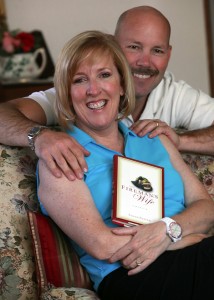By ALEXANDRA ROWE
PETALUMA TOWNS CORRESPONDENT
Susan Farren didn’t plan to become a firefighter’s wife, but over the years she came to accept it.
Her husband, Dan, took a job with the Petaluma Fire Department shortly after they were married, and still works there as a firefighter/paramedic. But until he was hurt while fighting a fire in 2002, Farren shared her emotions only with friends.

After paramedic Susan Farren’s firefighter husband Dan Farren was injured, she wrote a book about common themes first responders and families experience. (Kent Porter / PD)
Dan was blown from the roof of a burning building by the pressure of a ladder truck’s firehose, critically injuring him (but was saved by basic first aid) and leaving him unable to work for nearly a year.
As a way to record things that were happening so quickly in their time of crisis, Farren started a journal. She kept writing in it until she had fodder for a book about the struggles and fears of firefighters’ families.
In the wake of sad 9/11 memoirs, Farren’s book, “The Fireman’s Wife,” was refreshingly different, publishers told her. She had her pick, choosing Hyperion Books to publish it in 2005.
The book continues to sell, in part because Farren speaks so frankly about the issues shared by the families of other first responders. She also understands and eloquently describes the motivation of people who dedicate their lives to such a high risk profession.
“Dan would remind you, as most firefighters would, that he isn’t a hero,” she writes. “He’s just another person who was fortunate enough to follow his calling. For as long as he is able, he will continue to carry on the imperfect traditions and legacies of the fire service, knowing full well that he may one day be called to lay down his life for a stranger.”
On the 10th anniversary of the 9/11, Farren shares this chapter from “The Fireman’s Wife” …
Greater Love …
Never would the legacy of our connection to other firefighters and their wives be driven home more than on September 11, 2001. For the families of firefighters throughout the world, it wasn’t just the horror of what took place on our homeland or the grief that consumed us.
For the families of firefighters, the attack was personal. We imagined the faces of our own loved ones in every lost uniform. The names and faces of the lost men were unfamiliar, but their hearts were filled with the same loyalty, sacrifice and commitment to others that we knew. We were related to each other as we waited, watched and prayed with every firefighter’s family in the world that just one more firefighter would be found alive.
All of America saw past the frailties and weaknesses often associated with public servants that day, and saw the sacrifice given by those who don a uniform of any color to signify their commitment to the safety of our country and its people.
The New York City Fire Department was not alone in this disaster. Its inherent connection to every firefighter in the world just became more apparent. Firefighters and their families were suddenly all involved in some sort of effort to help those who had been left behind.
Fundraisers, blood drives and support programs for the hundreds of widows and children of the fallen heroes were in full swing in every department. Still other firefighters left their own families, friends and homes behind to board planes, load belongings into vehicles and head for ground zero to dig though the rubble.
The people and communities unrelated to the fire service showed their compassion and respect for the loss as they showered their support and sympathy on neighborhood fire stations, bringing food, flowers and cards of encouragement that continued to come in for weeks.
People everywhere seemed to realize that every firefighter in the world ran that last call, imagined the pressure, considered the risks, climbed the stairs in their minds.
They were helping the scared, the confused and the lost to find their way home, rushing past them, stopping only to render aid or offer breaths of fresh air from their own masks, to reach those who were higher up.
They were going in and up while everyone else was going down and out.Each one was wondering, would they have heard the rumbling?Would they have realized what was happening in the end?
And the brothers and sisters, bound invisibly to one another, cried, some behind closed doors, some openly, some in the arms of their families and some silently. But they all mourned; they all shared in the loss.
We cried with them as we saw the list of names on the department’s dry-erase and chalkboards grow longer every day, until every man was accounted for, 343 of them. We mourned in our hearts with their families as the symbol of each man was buried, putting to rest a life well lived.
The lost men are still honored in my husband’s department today, as I’m sure they are in a myriad of departments throughout the world. An enormous collage with the pictures and names of all those who gave their lives sits center stage on the wall of the main station’s day room, keeping their memories and legacy alive.
The healing has begun. As time continues her journey forward and the fire service transitions back into life as they know it, the loss of these colleagues remains firmly tucked in their hearts.
They remain nameless to those who didn’t know them personally, but have given the ultimate sacrifice. These men and women give meaning to the words found in John 15:13: “Greater love has no one than this, that he lay down his life for his friends.”
Susan Farren lives with her husband Dan and their five children in Rohnert Park.
